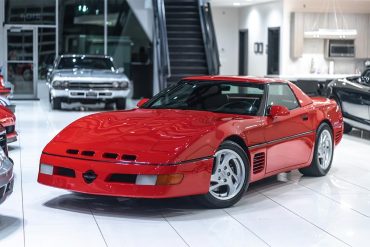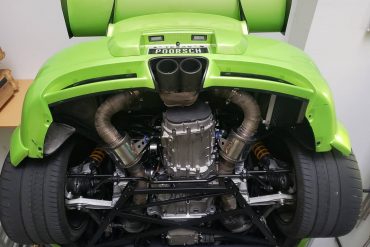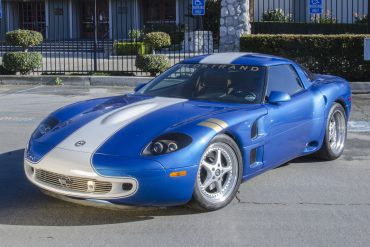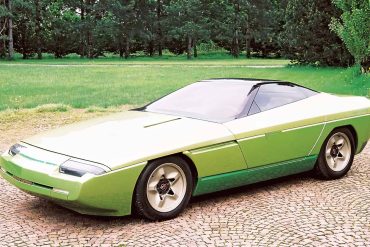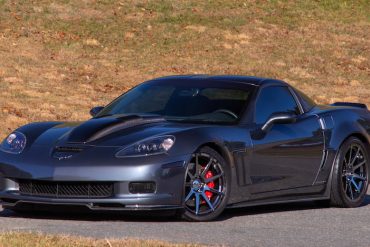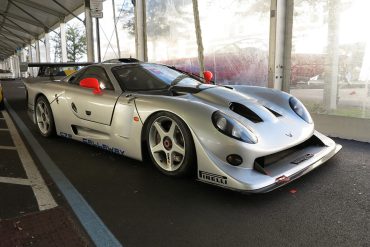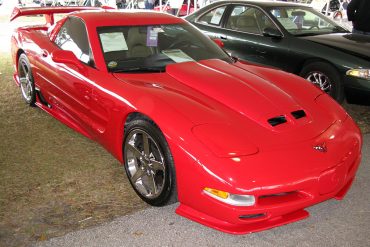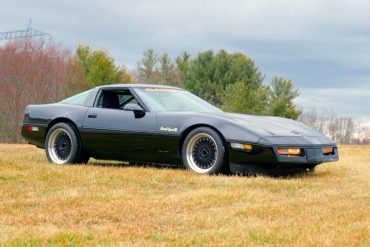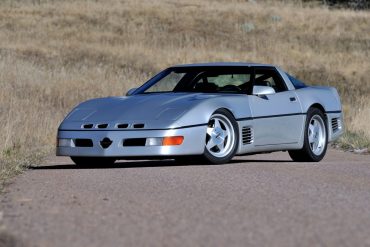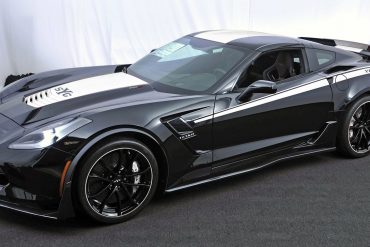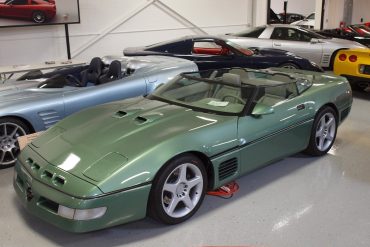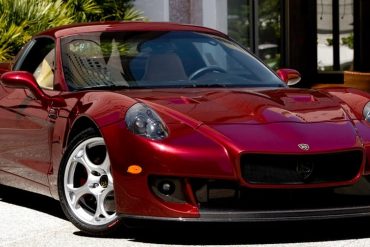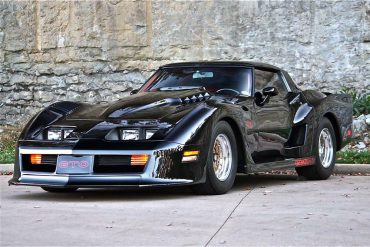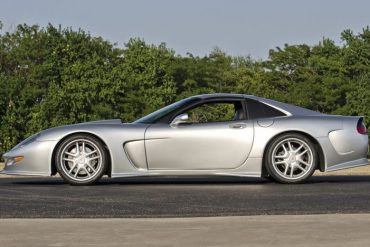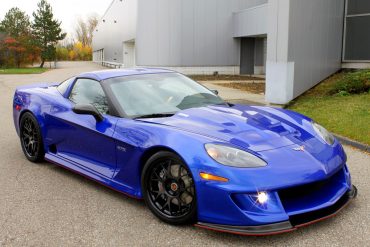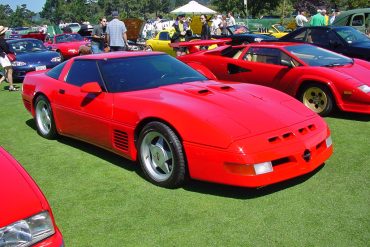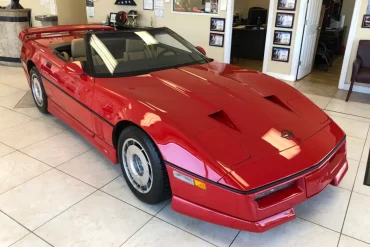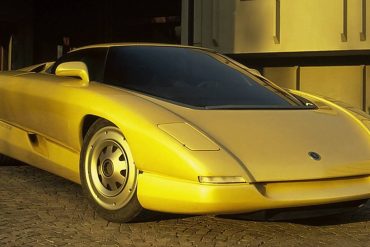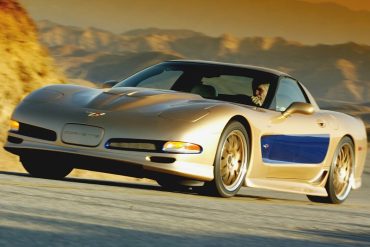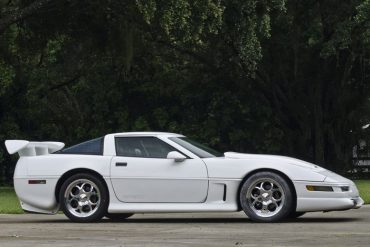Chevrolet's introduction of the LT1 in 1992 as the base engine in the Corvette phased out the L98 based Callaway Twin Turbo. Previously, Callaway Corvettes made their increased power through positive manifold pressure; now they made it through increased displacement and finesse. Initially called the CL1 or CR1, they designated the chassis they were built upon. They were based on the pushrod LT1 cars (CL1) or the 32 valve DOHC LT5 ZR-1 cars (CR1).
Check out this LS Powered Porsche Cayman! The Debate Is Over – How Do You Make A Porsche Faster? Stick...
As the story goes, when the Corvette ZR-1 came out in 1990, Dick Guldstrand saw an opportunity to create his vision of the perfect Grand Sport ride, instead of his name just getting slapped onto another Chevrolet product. He asked GM for fifteen ZR-1’s and some money. He got one car and permission to do whatever he wanted to do with it. And that’s exactly what he did. Called the "GS90", Dick's car would prove to be the most elaborate and expensive specialty Corvette ever built.
In 1983, Bertone began to explore the possibility of approaching the US market with the Ramarro, an exercise in applied technology around mass-produced mechanics. The Ramarro, which means "green lizard" in Italian, was created on the chassis of the well-known Chevrolet Corvette, and the underlying concept aimed to modify the layout of the mechanical components.
To commemorate its quarter-century milestone, Callaway Cars collaborated with Chevrolet, arranging a production run of 25 uniquely prepared 2012 Corvette Grand Sport coupes and convertibles. General Motors supplied special parts and procedures on the Bowling Green production line to facilitate final assembly at Callaway factories. Then, the performance and identity components are installed by Callaway. The 25th Anniversary Edition produced 620 bhp and 555 lb-ft of torque.
The Callaway C7 was a completely new, purpose-built car designed to embody the company’s motto: “Powerfully Engineered Automobiles”, carrying on the visual tradition of design by Paul Deutschman and offered in a limited production series. The C7 was the first complete, bespoke Callaway Automobile. This sportscar was equipped with a carbon chassis, front mid engine/rear transaxle design, 650 horsepower SuperNatural engine.
Not too dissimilar from this fourth generation Greenwood Corvette was this G5R. Again it was a performance resin bodykit that usually came along with a host of performance upgrades. Included was a front splitter, high rise hood, rear tunnel, rear wing, and windshield fairing. Greenwood has always been the leader in high performance aerodynamics and we are proud to offer the finest and most effective designs for your C5 Corvette.
When Dick Guldstrand introduced the GS80 series in 1986, the car was targeted specifically at Pro-Solo and autocross enthusiasts. He knew all about the needs of these groups, as he was a longtime provider of performance upgrades for the C3 and a direct supporter of a small team of racers from the Western Council of Corvette Clubs. Up to this point, Dick had basically been a tuner. With the intro of the GS80 he was venturing into the realm of small-volume manufacturing.
This Sledgehammer reached 254.76 mph at the Transportation Research Center (TRC) in Ohio and became the world’s fastest street-legal car for some time. It was built up by Reeves Callaway in Connecticut as an example of what was possible with the new ZR1 and and turbocharging its LT5 engine. The result was a 898 bhp coupe that still retained luxuries such as air conditioning and a radio. It got this power by using a NASCAR-spec block with Mahle pistons and a massive turbo.
The Specialty Engineering Group (SVE) has partnered with Chevy to create the 2019 Yenko/SC Corvette Stage II. This new Corvette, which is the creation of Specialty Vehicles Engineering in cooperation with Chevrolet, delivers an incredible 1000 horsepower and 875 lb-ft of torque. Better yet, it's an option that you can order from your local Chevy dealership.
In 1989 Callaway introduced a Speedster which was the culmination of their styling, engineering and trimming talents. Their first example was a bright green ZR1, which had a severely chopped windscreen, no side mirrors, eighteen inch wheels and a vibrant blue leather interior stitched purposefully from Germany. Nothing about Callaway’s Speedster was reserved, and this is especially true when investigating the specification. The car had 450 horsepower.
As early as the late 1990's, San Francisco based coach-builder SV Motor Company envisioned a car that took the raw performance of a Corvette and refined it with a touch of Italian flair. Their vision was to infuse many of the design elements found in the Alfa Romeo 8C Competizione (from which the SV 9 clearly drew its inspiration, as well as its name) with a 2009 Chevy Corvette.
The major differences between the 1980 and 1982 Daytona and the 1981 GTO are the hood, the tops of the rear fenders, and the rear spoiler/bumper cover. The Daytona had an elaborate, short vertical fin on top of the rear fender that turned several turns “in and back,” flowing to the wide, long, table-like rear spoiler. The GTO’s rear fenders pontoons are the same as.
Callaway has built a firm reputation for producing some of the most sophisticated and advanced Corvette-based automobiles. Introduced in 1998, Callaway’s C12 continued this proud legacy. Designed, developed and constructed by two top German engineering and development companies, Callaway and IVM, the C12 was intended as a bespoke, high-performance car that offered its occupants a civilized interior and relaxed ride. One of the most respected Corvette super-cars ever.
Based on the Corvette Z06, this new GTR also represents a collaboration between Specter Werkes and Lingenfelter Performance Engineering, with a Lingenfelter twin-turbo system powering the car – and pumping its 7.0-liter LS7 engine to 800 horsepower. Featuring dramatic bodywork and carbon fiber details, the GTR blends racing-inspired design cues with uncompromising luxury and performance.
When Chevrolet changed gears to the LT1 engine, Callaway revealed their new SuperNatural line and the CR1 based on the ZR1’s LT5. Options for the CR1 included the radical Aerobody, German upholstery and special wheels, brakes and exhausts. The CR1 used a larger displacement to produce either 475 or 490 bhp.
Offered from 1987 to 1991, the RPO-B2K upgrade was available from any Chevrolet dealer and also Callaway’s first major Corvette tuning program. Together, GM and Callaway made the upgrade package a Regular Production Order (RPO) which was the first time GM had outsourced such an option to a specialist manufacturer. It even had a factory back warranty. As the C4 updated, so did Callway’s program and by 1988, the B2K was pushing 382 bhp and 562 ft. lbs. of torque.
The Nivola may be considered Bertone’s homage to the most fascinating American sports car: the Chevrolet Corvette. The sophisticated mechanical unit of the ZR-1 was interpreted by Bertone in a European key. Bertone designed a special chassis to make a sporty "boat" with a mid engine. This mechanical layout made it possible to exploit all the power of the engine when accelerating and warrant perfect roadholding on bends.
In 2003 Dick produced his version of a 50th Anniversary Corvette. Dick’s 50th Anniversary Corvette was bright gold with blue accents. And of course a “special” Corvette should be the toughest available version, which in 2003 was the Z06. And to top it all off, the Z06’s LS6 was opened up to the magical “426 CID.” The GS80 came out in 1986 that was more or less a Showroom Stock-prepared black beauty with very trendy lace wheels.
For the fourth generation Corvette, legendary Corvette racer John Greenwood developed the G4R. It was essentially a radical bodykit that usually followed a high level of performance upgrades. Included was a ground effects package that had integrated lights on the front valance. Furthermore the a new engine scoop and rear wing were fitted.
No More Content


